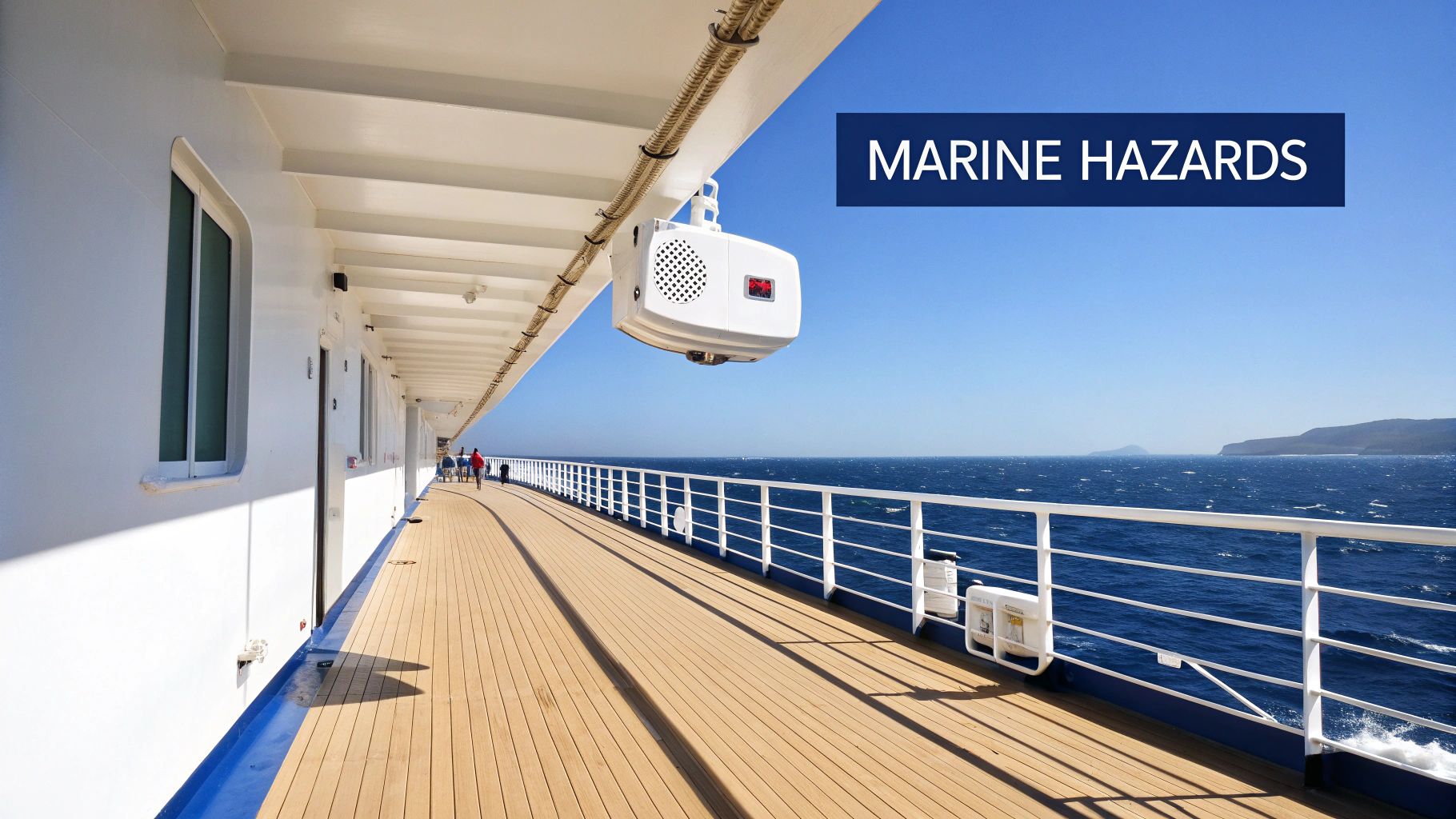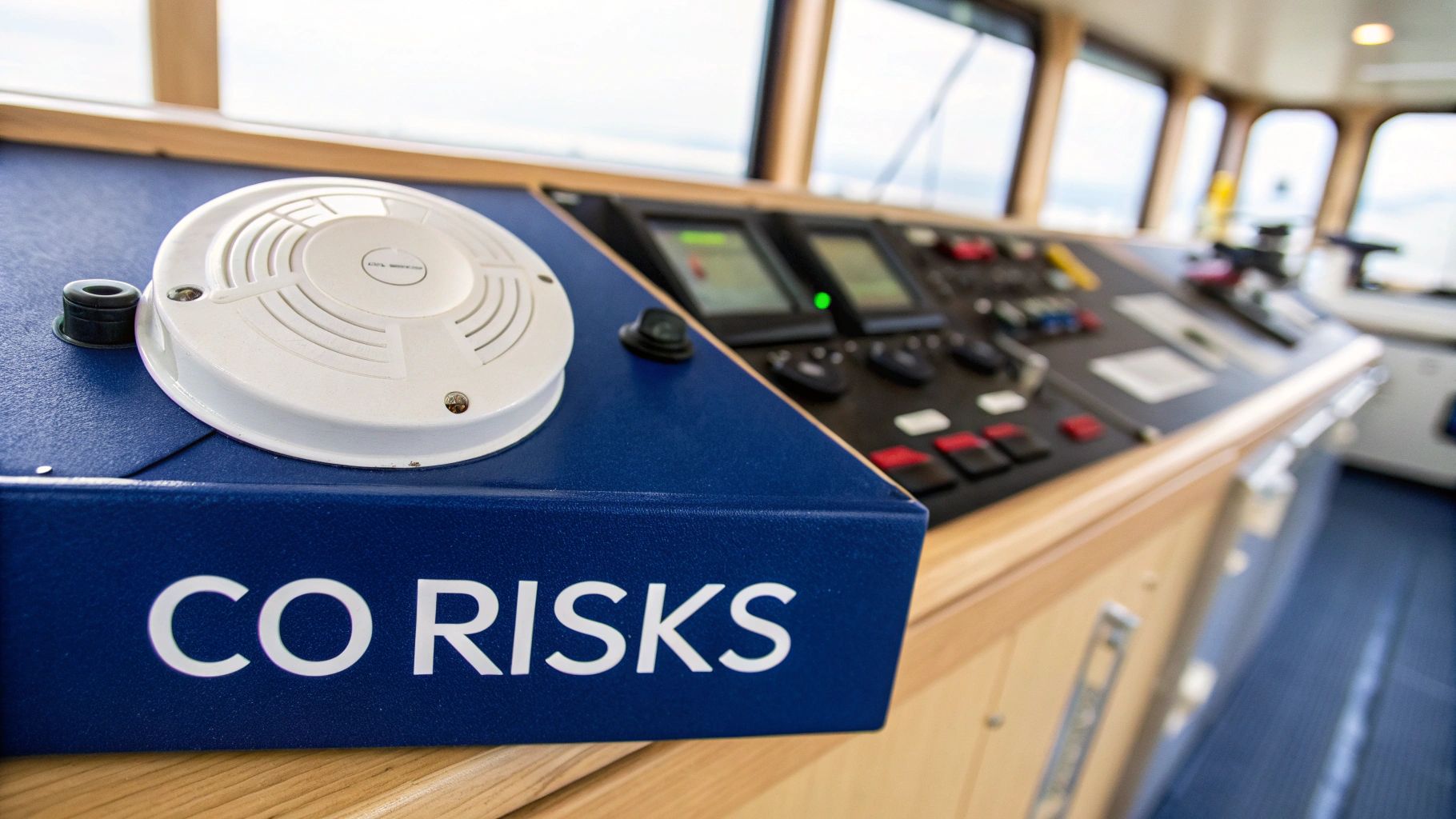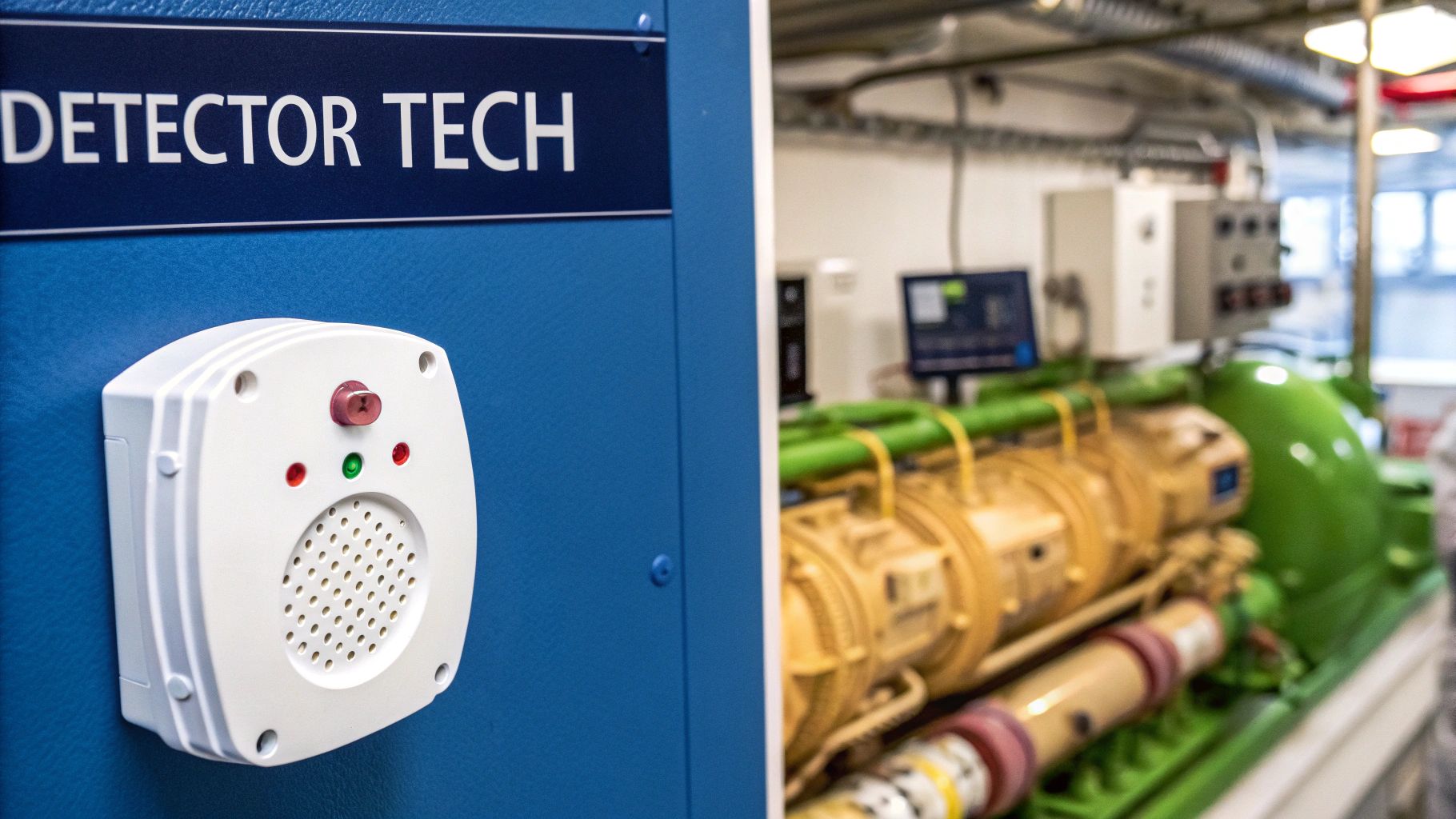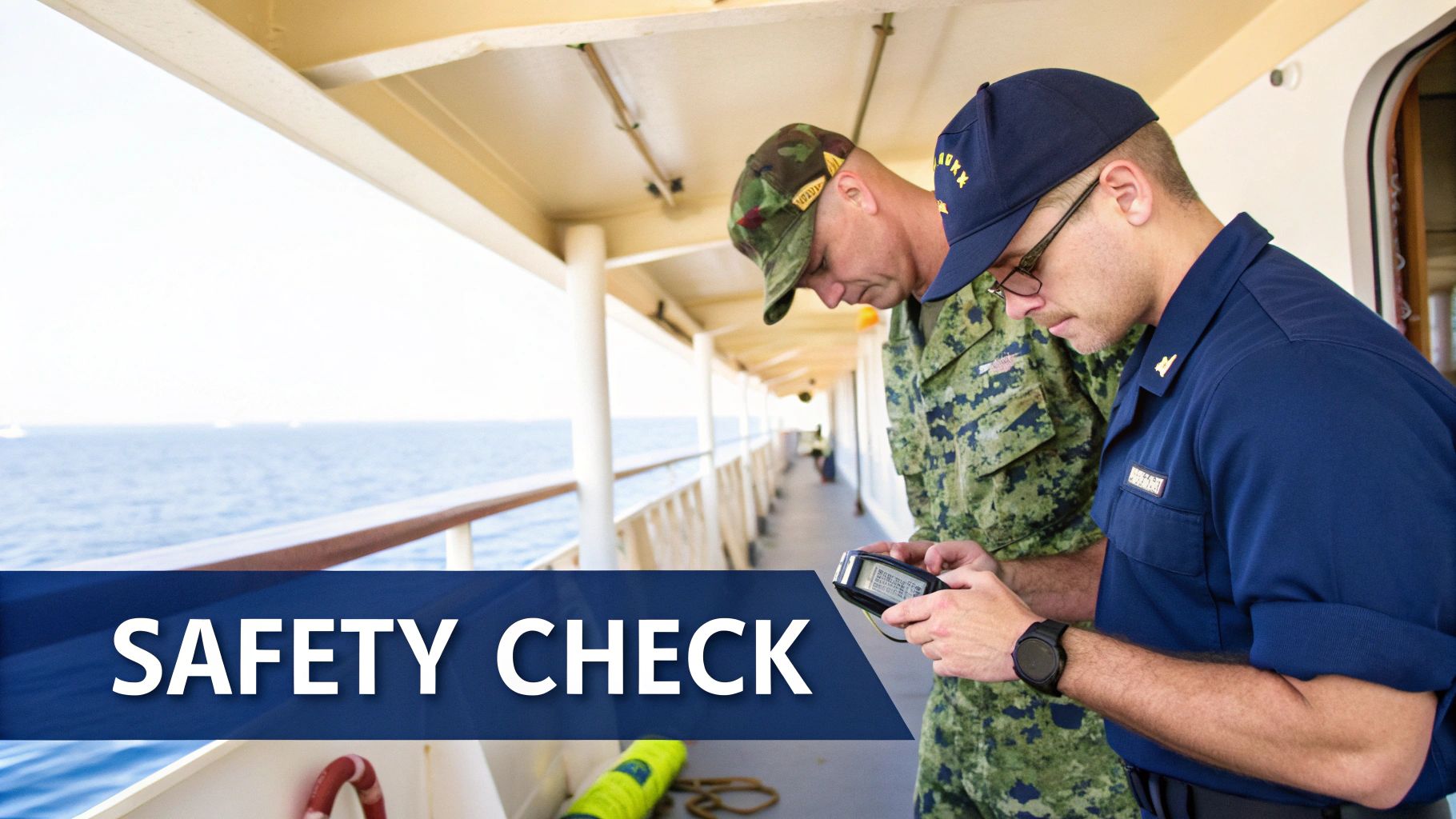The Invisible Threat: Why CO Is a Boater's Nightmare
Carbon monoxide (CO) is often called the "silent killer." This name is especially true around boats. This odorless, colorless gas is created when engines, generators, cooking appliances, and heaters don't burn fuel completely. CO is dangerous anywhere, but on a boat, it's a serious threat.
Boats have many small, enclosed spaces. Think of your boat's cabin as a container. When appliances make CO, it gets trapped. The CO builds up to dangerous levels much faster than it would in a house with open windows. This can quickly overwhelm anyone onboard.
The movement of a boat and the wind can create pockets of CO. These pockets can linger and move around. This means even if you move to another part of the boat, you might still be in danger. These moving pockets of CO make it hard to find the source and escape. A spot on the deck that seems safe could become a CO trap if the wind or boat speed changes.
Regular home CO detectors often aren't good enough for boats. They aren't built for the humidity, salt spray, and constant vibrations on a boat. This can cause false alarms, or worse, they might not detect CO at all. Marine carbon monoxide detectors are specifically designed for boats, making them more reliable. Over the past few decades, the use of marine CO detectors has become increasingly important due to the dangers of CO poisoning. Between 2005 and 2018, at least 78 deaths from CO poisoning were reported on boats in the United States.
CO Detector for Boat and Marine - Best Picks
Despite these risks, the use of CO detectors on boats hasn't increased as much as it should. The American Boat and Yacht Council now requires CO detectors in all new boats with gasoline inboards or generators. However, stronger regulations and enforcement are still needed.
Understanding the Risks
CO poisoning symptoms, like headaches, nausea, and dizziness, are easily mistaken for seasickness or tiredness. This can delay diagnosis, which can be dangerous as CO levels rise.
Protecting Yourself and Your Passengers
Choosing a marine-grade CO detector is crucial for your safety. These detectors are built for the harsh conditions on boats. Proper installation is just as important as choosing the right detector. Placement should consider possible CO sources and how air flows through your boat.
Read also: Sitemap

Understanding the dangers of CO on boats and taking precautions will help keep your boating experience enjoyable and safe.
From Primitive to Profound: The Evolution of Marine CO Detection

Early methods for detecting carbon monoxide (CO) on boats were basic. Color-changing gels were often used, but they weren't very accurate and needed frequent replacement. These methods were a far cry from the technology we have today. But they were a vital first step in understanding the dangers of invisible CO on boats.
This understanding led to a push for better detection methods.
The evolution of marine carbon monoxide detectors reflects the progress made in sensor technology. Early detectors adapted industrial CO sensors for marine use. But these struggled in the harsh marine environment.
High humidity, constant vibration, and corrosive salt spray often caused malfunctions and false alarms. Overcoming these challenges was critical for developing reliable marine-specific CO detectors. This led to improvements in waterproofing, corrosion-resistant materials, and more stable sensor technology.
The arrival of electrochemical sensors was a major step forward. These sensors are more sensitive and accurate than older technologies. They are less affected by humidity and temperature changes. They also last longer, reducing the need for frequent replacements. This increased reliability is vital for boat safety.
The development of marine CO detectors has been shaped by both technological advancements and regulations. Initially, CO detectors were designed for industrial use, with significant advancements in sensor technology happening in the 1970s and 1980s. Marine detectors, however, need to withstand harsh conditions and minimize false alarms, which can lead to people disabling the devices. Underwriters Laboratories (UL) has played a key role in setting standards, such as UL STD 2034 for marine CO detectors, highlighting the importance of reliable and early warning systems to protect lives. You can learn more about this evolution here.
Modern Marvels of Marine Safety
Today's marine CO detectors are much more advanced. Microprocessor technology allows for sophisticated self-diagnostics and alarm systems. Detectors can now identify problems and warn boaters of potential issues.
Many modern detectors also have digital displays. These displays show real-time CO levels, providing more information than a simple alarm. This allows boaters to take action before CO levels become dangerous.
The Future of CO Detection on the Water
The future of marine CO detection will likely involve even deeper integration with boat systems. Detectors might automatically turn on ventilation systems or shut down CO sources when dangerous levels are detected.
Wireless connectivity and smart technology will likely play a bigger role too, enabling remote monitoring and alerts through smartphones and other devices. These advancements will further improve boating safety and offer greater peace of mind.
Beyond Basic Detection: What Makes Marine CO Detectors Different

Your boat isn't your house. This means your home carbon monoxide detector isn’t enough to keep you safe on the water. Marine carbon monoxide detectors are designed for the harsh conditions of the marine environment. They’re built with features like waterproofing, robust power management, and highly sensitive sensors. This explains why marine-grade detectors typically come with a higher price tag.
Waterproofing and Durability
One of the biggest differences between marine and home CO detectors is their durability. Marine detectors are waterproofed to protect them from rain, splashes, and salt spray. This ensures they work reliably, even in wet environments. They’re also corrosion-resistant to combat the effects of salty marine air, extending their lifespan and maintaining effectiveness. This long-lasting performance is vital for safety at sea.
Power Management and Mounting
Marine CO detectors usually run on 12-volt DC power from your boat’s electrical system. This offers a consistent power supply, so you don’t need to worry about changing batteries. Some models also include battery backups as an extra safety measure against power outages. Mounting is also different for marine detectors. They’re designed for the vibrations and constant movement of a boat, something regular home detectors aren't built for.
Sensor Sensitivity and Accuracy
On a boat, engine noise, constant motion, and changes in humidity can affect CO detection. Marine detectors are engineered to handle these conditions. They have specialized sensors and software that reduce false alarms while remaining sensitive to the presence of CO. This accuracy is essential for distinguishing real danger from environmental factors. You might be interested in: How to master...
Marine Certifications and Essential Features
When choosing a marine CO detector, look for industry certifications, such as UL 2034 certification. This indicates rigorous testing and adherence to marine-specific safety requirements. Boaters also value features like end-of-life warnings, which tell you when it’s time to replace the sensor. Self-testing capabilities provide further peace of mind.
The following table highlights the key differences between standard home CO detectors and specialized marine models:
Marine vs. Home CO Detector Comparison
This table compares the essential differences between standard home carbon monoxide detectors and specialized marine models across key performance and durability factors.
| Feature | Standard Home CO Detector | Marine-Grade CO Detector | Why It Matters |
|---|---|---|---|
| Power Source | Typically battery-powered | Usually 12V DC, sometimes with battery backup | Reliable power is crucial on a boat |
| Waterproofing | Not waterproof | Waterproof and corrosion-resistant | Essential for withstanding harsh marine conditions |
| Sensor Sensitivity | Designed for stable home environments | Compensates for boat movement, engine noise, and humidity | Minimizes false alarms while maintaining accuracy |
| Mounting | Simple wall mounting | Designed for marine environments, accounts for vibration | Ensures secure and stable placement on a boat |
| Certifications | UL 2034 not required | UL 2034 recommended | Meets stringent marine safety standards |
| Durability | Lower | Higher | Longer lifespan in harsh conditions |
As this comparison shows, choosing the right CO detector for your boat is vital.
Experienced boaters understand that reliable safety equipment is a must-have. A marine carbon monoxide detector is not something to compromise on. The extra features and durability offer superior protection against carbon monoxide, giving you peace of mind on the water.
Strategic Installation: Placement That Actually Protects

Picking the right marine carbon monoxide detector is essential, but proper installation is just as critical. Even the best detector is useless if it's not installed correctly. This section uses expert advice and Coast Guard investigations to help you understand the best placement strategies for your boat.
Location, Location, Location: General Placement Guidelines
Carbon monoxide is a bit lighter than air, but it mixes easily. This means you don't have to place your detector right on the floor, but avoid mounting it too high. Putting a detector directly over the galley stove, for example, won't be effective. Instead, choose a spot with good air circulation where the detector isn't blocked.
Also, think about the potential sources of CO on your boat. Engines, generators, and heating systems are the usual suspects. Place your detector(s) where they can quickly pick up leaks from these sources. You might need multiple detectors in different areas, especially on larger boats.
Tailoring Placement to Vessel Type
Different boat designs call for different placement strategies. Sailboats often have enclosed engine compartments, so a dedicated detector in that area is necessary. On a motorboat, the engine compartment might be more open to the cabin, making a central location more suitable.
Cabin layouts also play a role. A detector in a forward cabin might not detect CO from a generator located at the back of the boat. In cases like this, multiple detectors placed strategically throughout the boat are essential.
Common Installation Mistakes and How to Avoid Them
There are some common installation mistakes that can seriously impact a CO detector's performance. Mounting a detector near air conditioning or heating vents can cause false alarms or inaccurate readings. Similarly, placing a detector in a spot with no air circulation, like behind a curtain, won't allow it to sample the air properly.
Incorrect wiring and a lack of weatherproofing are other common errors. Make sure all connections are secure and protected from moisture to prevent corrosion and ensure the detector continues working reliably. This is especially important in the harsh marine environment.
Troubleshooting False Alarms
False alarms can tempt boaters to disable their CO detectors, a potentially dangerous move. If you get a false alarm, investigate the cause before simply turning off the device. Dust, humidity, or nearby chemical fumes can all trigger false alarms. Regular cleaning and good ventilation often solve the problem. However, if false alarms continue, the detector may be malfunctioning and need replacing.
Connecting your CO detection system with other safety equipment, like your bilge alarm, can further improve your overall safety. This creates a comprehensive safety net, giving you early warnings of different potential hazards.
By following these guidelines and avoiding common mistakes, you can ensure your marine carbon monoxide detector provides the protection you and your passengers need. Don’t just install a detector – install it strategically. This proactive approach is vital for safe boating.
Navigating the Regulatory Landscape of Marine CO Safety
The importance of marine carbon monoxide detectors is undeniable. However, the regulations surrounding their use are surprisingly inconsistent. This fragmented regulatory landscape can be confusing for boaters and highlights the need for greater standardization. Many jurisdictions require CO detectors on newer boats with enclosed accommodation spaces and gasoline engines. But older vessels often aren't covered by these regulations, meaning many boaters may be unknowingly at risk.
Understanding the Patchwork of Regulations
The rules around CO detectors vary significantly. Factors like vessel size, engine type, and boating location all play a role. Some areas have no specific regulations at all, leaving boaters to rely on their own judgment. This patchwork of rules makes it difficult for boaters to stay informed and compliant. It also underscores the importance of proactive safety measures, regardless of local laws. You might be interested in: Our Collection.
The Role of Insurance Companies
Even without strict legal requirements, many insurance companies now require the installation of marine carbon monoxide detectors. They recognize that CO poisoning is a serious risk and want to mitigate potential claims. This proactive approach by insurers highlights the growing awareness of CO dangers in the boating world.
Jurisdictions Leading the Way
Some jurisdictions are taking CO safety more seriously. Several US states, for example, have mandatory CO detector laws for boats with enclosed cabins and gasoline-powered engines or generators. These stricter standards serve as models for other regions and demonstrate a real commitment to boater safety.
The Gap Between Commercial and Recreational Vessels
Commercial vessels typically face stricter regulations than recreational boats. This is due to the higher occupancy and greater potential loss of life in a CO incident. While these stringent rules protect commercial crews, they also highlight the difference in safety standards between the two sectors.
Advocacy for Standardized Protection
Several organizations are working to standardize CO safety regulations across all boating activities. These groups aim to close the gaps in current regulations and ensure all boaters have adequate CO protection, no matter their vessel type or location. This work is crucial for establishing consistent safety standards and minimizing the risk of CO poisoning. This increased awareness and advocacy are pushing for more uniform regulations and a safer boating environment for everyone.
The Elite Eight: Top Marine Carbon Monoxide Detectors Compared
Choosing the right marine carbon monoxide detector can be a daunting task. With so many options available, it's easy to get lost in the sea of marketing jargon. This comparison aims to provide clear, practical guidance based on real-world testing and feedback from seasoned boaters. We'll explore how different models stand up to the rigors of the marine environment, from engine vibrations to salty spray, empowering you to make a confident choice for your vessel.
Understanding Key Features
Several key factors set marine CO detectors apart. Sensor type plays a vital role in a detector's accuracy and lifespan. Electrochemical sensors are generally preferred for their precise detection and resilience to environmental factors. A reliable power source is essential, with 12V DC powered detectors providing a continuous power supply, often backed up by batteries. Battery life is a critical consideration for both backup systems and portable detectors. The waterproof rating, typically expressed as an IP code, indicates how well a detector can withstand harsh marine conditions. Lastly, special features such as end-of-life warnings and self-testing functions enhance safety and user convenience.
Comparing Top Models
To help you choose the best marine carbon monoxide detector, we've compiled a comparison table. This table summarizes the key features, specifications, and price ranges of some top-rated models. Remember that prices are approximate and can vary depending on the retailer.
Marine CO Detector Comparison Table: Compare top-rated marine carbon monoxide detectors across critical specifications, features, and price points to find the best option for your vessel.
| Model | Sensor Type | Power Source | Battery Life | Waterproof Rating | Price Range | Special Features | Best For |
|---|---|---|---|---|---|---|---|
| Example Model A | Electrochemical | 12V DC w/ Battery Backup | 5 Years | IP67 | $80 - $100 | End-of-life warning, self-test | Smaller boats, day cruisers |
| Example Model B | Electrochemical | 12V DC | N/A | IP66 | $60 - $80 | Digital display, alarm mute | Budget-conscious boaters |
| Example Model C | Semiconductor | 12V DC w/ Battery Backup | 7 Years | IP67 | $100 - $120 | Interconnectivity with other alarms | Larger vessels, liveaboards |
| Example Model D | Electrochemical | Battery Powered | 5 Years | IP67 | $70 - $90 | Compact design, portable | Sailboats, dinghies |
| Example Model E | Electrochemical | 12V DC | N/A | IP66 | $50 - $70 | Simple installation | Basic CO protection |
| Example Model F | Electrochemical | 12V DC w/ Battery Backup | 10 Years | IP68 | $120 - $150 | Advanced self-diagnostics | High-end boats, demanding conditions |
| Example Model G | Semiconductor | Battery Powered | 3 Years | IP65 | $40 - $60 | Low cost | Temporary or emergency use |
| Example Model H | Electrochemical | 12V DC | N/A | IP67 | $90 - $110 | Remote monitoring via app | Tech-savvy boaters |
As you can see, the options range from basic models to those with advanced features. Consider your specific needs and budget when making your selection.
Choosing the Right Detector for Your Needs
The ideal marine carbon monoxide detector depends on several factors, including your vessel type and individual requirements. A basic model with reliable electrochemical sensors and a good waterproof rating may be sufficient for smaller boats or day cruisers. Larger vessels and liveaboards may benefit from more advanced features, such as integration with other alarm systems or remote monitoring capabilities. Budget-conscious boaters can find reliable detectors without the premium price tag. Those prioritizing maximum protection should look for models with advanced self-diagnostics and extended battery backups. Ensure any detector you choose adheres to UL 2034 standards and is installed correctly for optimal performance.
For instance, a small sailboat with limited electrical systems might be well-suited to a battery-powered detector like "Example Model D." A larger yacht with a complex electrical system could opt for a feature-rich, interconnected model like "Example Model C" or a technologically advanced option such as "Example Model H." This allows boaters to customize their CO detection system to their specific needs, ensuring safety and peace of mind.
Investing in Peace of Mind
A marine carbon monoxide detector is a vital piece of safety equipment for any boat. By understanding key features and comparing top models, you can make an informed choice to protect yourself and your passengers from the dangers of CO. Don't skimp on safety—invest in a dependable detector that can handle the marine environment.
Ready for a safer and more convenient fueling experience? Check out CLiX Fueling Solutions and see the difference! Learn more about CLiX Fueling Solutions












